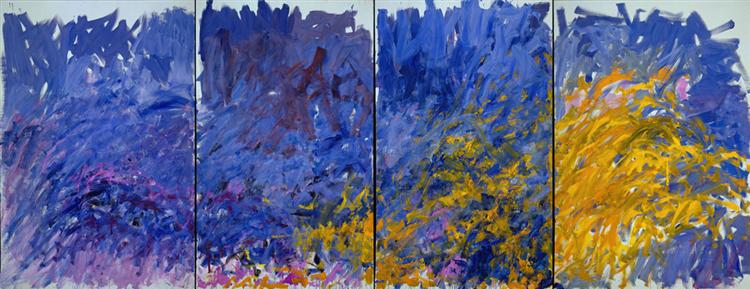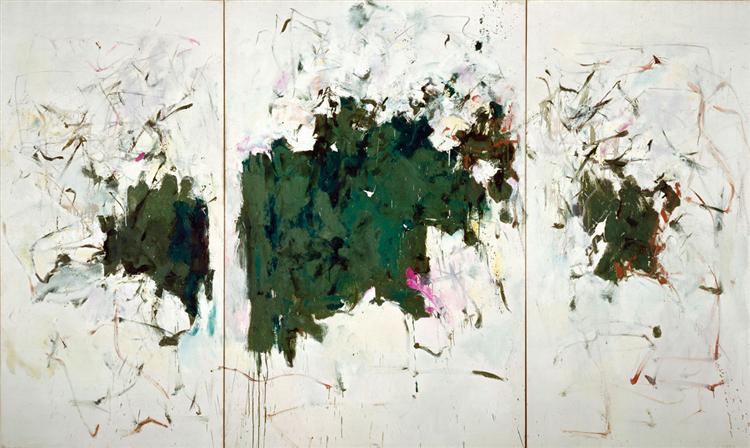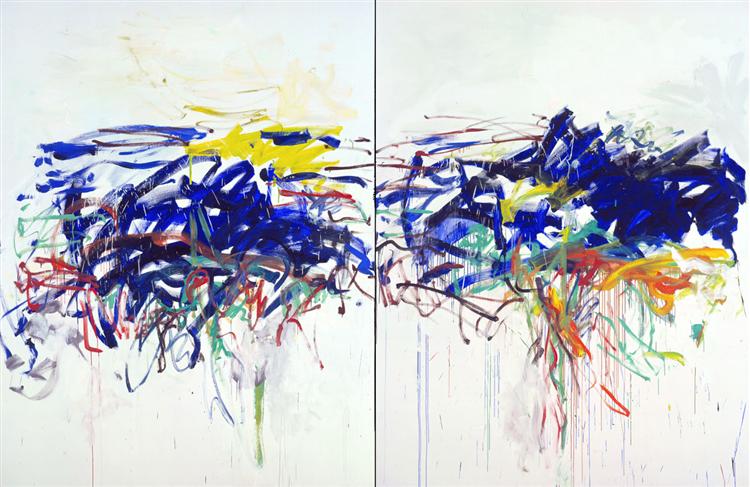Joan Mitchell was a highly significant figure in Western art, particularly within the Abstract Expressionist movement. She was born in Chicago in 1925 and graduated with a BFA from the Art Institute of Chicago in 1947. She spent time with numerous other painters and poets while taking part in the thriving downtown New York art scene in the early 1950s. In New York, she started painting in the style known as Abstract Expressionism. She relocated to Paris, France, in 1955, and from the capital, she moved to a home in Vétheuil, a tiny hamlet close to Paris, in 1967. She had more room to paint and was surrounded by nature at Vétheuil.
Mitchell’s house was perched atop a hill with a view of the Seine River. The land featured large trees and gardens where she raised various plants and flowers, her favourite being sunflowers. Joan loved her dogs dearly; during her life, she had numerous dogs, and the titles of her paintings frequently feature their names. Joan Mitchell spent her whole life as a painter. She created drawings, particularly in pastel and watercolour, and did several printmaking techniques in addition to oil paintings. Mitchell passed away in 1992.
Art of Joan Mitchell
Mitchell belonged to the American movement known as the second generation of Abstract Expressionists, which originated after World War II. She collaborated with artists such as Mark Rothko, Willem de Kooning, and Jackson Pollock to define and create this groundbreaking painting movement. Mitchell’s artwork is distinguished by its vibrant colours and energetic, painterly brushwork. She was renowned for using paint vividly and expressively, frequently evoking a feeling of movement and passion. Her paintings are vibrant and alive, perfectly encapsulating her feelings and environment.
The natural environment served as a source of inspiration for Mitchell, especially the scenery in her native Midwest and later her experiences living in France. Without depicting them, her abstract creations frequently evoke the sensation of natural phenomena like flowers, landscapes, and weather patterns. Mitchell creates incredibly intimate and passionate paintings. She famously said, “I carry my landscapes around with me,” demonstrating how deeply ingrained her environment was in her work. Her pieces frequently convey various feelings, from vigour and happiness to reflection and sadness.

As a woman in a male-dominated art world, Mitchell faced numerous challenges and obstacles throughout her career. Despite this, she achieved great success and recognition for her work. Mitchell’s accomplishments inspire female artists and feminist art historians, who celebrate her as a pioneering figure in the fight for gender equality in the arts. Mitchell’s impact on subsequent generations of artists cannot be overstated. Her bold, gestural style has inspired countless painters, and her legacy continues to be celebrated in exhibitions, publications, and academic studies. She remains a towering figure in the history of 20th-century art, revered for her contributions to Abstract Expressionism and her singular vision as an artist.
Joan Mitchell: Remembering in Color
[Joan was] Tough, vulnerable, loving, bawdy, bullying, embattled, generous, and enraged; she was as singular as her art, writes Patricia Albers in her book, ‘Joan Mitchell: Lady Painter’. According to the author, ‘The first time you meet her, she might insult you, even make you cry, but later, she might be so understanding and nurturing that she feels like a soulmate. Moreover, Joan sometimes made strange comments, which people tended to chalk up to drunkenness (she was a prodigious drinker) metaphor or the mark of the artistic personality. For instance, she described her painting as a ‘sort of scaffolding made of painting stretchers around a lot of coloured chaos’.
Albers explained that Joan, in her book, was the artist who had a neurological problem, which made her so vibrant in colours and applied that to the canvas: ‘Joan’s synesthesia and eidetic memory, I realised, left their tracks all over her art. I don’t mean to suggest that she was a primitive who simply mapped her neurological experience onto canvas. On the contrary, the consummate painter, Joan, used all of her craft plus every scrap of experience at her disposal, including the perceptual “otherness” that helped her to swing open a window beyond the narrow crack of everyday awareness and create art of a rare incandescence.
The theoretical background of Modernism, primarily abstract expressionism, gives her an in-depth conflict between theory and practical, as claimed, ‘Indeed, she did not invent a new ism. Not only was her art formally idiosyncratic—above all, she was a supreme colourist—but it also displayed what essayist and philosopher Ralph Waldo Emerson terms “an original relation to the universe.”

In writing about Joan, American poet John Yau places her into a mythical realm that makes her an angel of colours and stated, ‘The probing, shifting, subtle, and brilliant internal conversations that Mitchell carried with various artists while working in her studio — whether in New York, Paris, or the French countryside — ultimately ended with them exiting, leaving her on her own, charging ahead. More importantly, when she began drawing loosely and impulsively with a brush around 1951-52, she defined her territory and accumulated her arsenal of painterly possibilities. Mitchell was never a follower. Her gestural paintings are not like those of de Kooning or Kline. She was inspired by the things that they and others, like Mark Rothko and Adolph Gottlieb, did in their work, but by the time brushstrokes and forms appeared on her canvases, they were all her own.
Are you vulnerable? This question is yet to be answered in Joan’s case, as she always claimed, “No one can paint —write—feel whatever without being vulnerable … Also, one has to be very strong to be vulnerable. Think about it,” In his short note, John Yau mentioned an exhibition, ‘Joan Mitchell: I carry my landscape around with me’, and claimed she explored the thematic areas that even de Kooning and Kline never explored.
John Yau observed that Mitchell’s approach is straightforward: she uses a specific brush to apply a particular colour. Moving across the canvas, she changes the paint’s brush, colour, and viscosity. At no point does she scrape down or rub out what she has done. She goes forward without circling back.
The significance of Joan Mitchell in the art world cannot be emphasized and ignored as they counted as a pointer in the Abstract Expressionist movement, which completely changed our understanding of and interactions with paintings. Mitchell infused her work with vibrancy and emotion that still enthrals audiences today through her inventive use of colour, gesture, and form.
Her investigation of the natural world and environment and her intensely introspective and reflective painting style produced a corpus of wonderful and profoundly moving paintings. The significance of Mitchell’s legacy is further highlighted by the fact that she broke down barriers and disregarded expectations in the male-dominated art world, making her a feminist icon.





